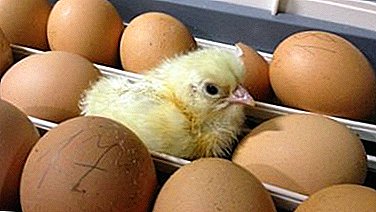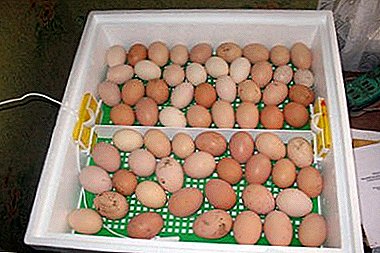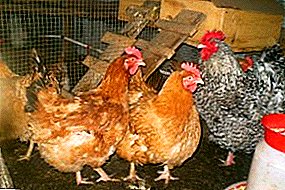
Incubation of chicken eggs is very troublesome, but with the right approach, the result will please the host.
The process should be treated with full responsibility, otherwise there are risks to kill offspring. Let's talk in more detail in our article about the mode of incubation of chicken eggs.
Checking eggs before laying
Checking chicken eggs is called ovoscoping. This process is the scanning of eggs with a beam of directional light, which allows you to see the contents.
 It often happens that the externally perfect testicle has a pathology. Ovoskopirovaniya minimizes the laying of eggs with internal pathology. Experienced farmers shine eggs with an ovoscope. In the absence of this special device, you can use a candle, lantern or any lamp.
It often happens that the externally perfect testicle has a pathology. Ovoskopirovaniya minimizes the laying of eggs with internal pathology. Experienced farmers shine eggs with an ovoscope. In the absence of this special device, you can use a candle, lantern or any lamp.
The first time they digest the eggs before laying them in the incubator. At this stage, fertilization and the presence of microcracks in the shell are established.
Important! Eggs with cracks in the shell can not be laid in the incubator.
Signs of quality eggs:
- The shell must be clean, flat, smooth. On its surface there should be no dents, protrusions or stripes, cracks.
- The contour of the yolk is clearly delineated and located in the center. The yolk is round, smooth.
- The pug is at the blunt end of the egg, small in size.
- The content of the egg should be transparent: without parasite eggs, blood clots and feathers inside.
The rejected eggs are removed, and the appropriate eggs are carefully disinfected and placed in an incubator. Re-ovoskopiruyut eggs a week after laying and the third time at 11-14 days.
Read more about the rules for selecting and testing eggs for incubation in this article.
Check the health of the device
The first time the device is run empty to identify possible defects. The incubator runs idle for 3 days. Next, the machine is washed, dried, inspected for external damage. The doors of the device should fit snugly to the body, but it is easy to open at the same time.
Check the operation of the fan, humidifier, heating elements, lighting devices of the incubator. Fan operation is checked by manually rotating the impeller.
Recommendations! Blades should not touch other elements. Trays must fit tightly into their seats without interfering with the locking of the locks.
Before starting the incubator, ensure the integrity of the grounding contacts, the absence of foreign objects from moving parts. The device is installed on a horizontal surface so that it does not stagger, avoiding drafts.
We told in our material about what types of incubators exist and how to make this device with our own hands.
How to bookmark?
 Selected eggs should be in the room before being immersed in the incubator. Otherwise, immersing them in a heated chamber produces condensate. This will lead to climate disruption and mold, which is fatal to the embryo.
Selected eggs should be in the room before being immersed in the incubator. Otherwise, immersing them in a heated chamber produces condensate. This will lead to climate disruption and mold, which is fatal to the embryo.
Therefore, 8-12 hours before incubation, the eggs are kept at a temperature of 25 ° C, avoiding drafts. It is advisable to lay chicken eggs horizontally (for more information on how long chicken eggs are incubated and what its duration depends on, see here).
Then they warm up evenly. Although vertical styling is permissible. Eggs are placed on trays in groups at regular intervals (4 hours): first large, then medium, at the end small.
Bookmark Algorithm:
- Heat the incubator to the set temperature.
- Treat eggs with antiseptic or disinfect with ultraviolet light.
- Spread the eggs on the tray.
- Immerse the tray in the incubator.
- Close the unit door tightly.
Many incubator models have an automatic egg reversal. If there is no such function, the eggs are turned manually 10 to 12 times a day.
Temperature, humidity and other parameters in different periods and types of incubators (table)
The air in the device should not warm up more than 43 ° C. A brief overcooling (not below 27 ° C) or overheating of eggs (not longer than a couple of minutes) is allowed. Details about what temperature should be the incubation of chicken eggs, read here.
If the heat source is localized from above, then it is optimal to maintain 40 ° C at the top cover. If the heating elements from all sides, then 38.5 ° C. The lower norm of air humidity is 45%, the upper one is 82%. The level of humidity varies relative to the incubation period.
Important! Leaps in temperature and humidity slow down ontogenesis and are fraught with diseases in future chicks.
Table of optimal temperature and number of inversions during incubation of chicken eggs
| Days | Temperature, ° С | Turning, once a day |
| 1-7 | 37,8 - 38 | At least 6 |
| 8-14 | 37,8 - 38 | 5 - 6 |
| 15-18 | 37,8 | 4 - 5 |
| 19-21 | 37,5 - 37,7 | - |
Table of compliance humidity and temperature during incubation
| Days | Temperature, ° С | Humidity,% |
| 1-7 | 37,8 - 38 | 50-55 |
| 8-14 | 37,8 - 38 | 45-50 |
| 15-18 | 37,8 | 50 |
| 19-21 | 37,5 - 37,7 | 65-70 |
Norms of incubation in a foam incubator (such as Blitz). The foam device is different from the mechanical. And the technology is great too.
| Day | Temperature | Humidity | Reversal | Cooling (times * minutes) |
| 1-3 | 37,8-38 | 65-70 | At least 2-3 times a day | - |
| 4-13 | 37,5-37,8 | 55 | 1 * 5 | |
| 14-17 | 37,5-37,8 | 70-75 | 2 * 5 | |
| 18-19 | 37,2-37,5 | 70-75 | Just shifting | 3 * 10 |
| 20 | 37,2-37,5 | 70-75 | - | 3 * 10 |
| 21 | 37,2-37,5 | 70-75 | - | - |
When hatching eggs at home, it is recommended to keep a schedule of incubation records, where to record the actions and features that occur with eggs, comparing with the values from the tables.
Watch a video about the incubation of chicken eggs, temperature and humidity in the incubator:
Phases of breeding by day and optimal temperature values
The whole process of incubating chicken eggs averages 20-22 days. Sometimes for 1-2 days longer due to low temperature in the incubator. But more than 25 days should not wait. Conventionally, these 22 days can be divided into 4 stages:
- From 1 to 7 day.
- From 8 to 14 day.
- From 15 to 18 days.
- From 19 to 21 days.
The following are important points for different periods that you need to know.
- 14 day incubating chicken eggs.
 In the mechanical incubator, the temperature is maintained in the range of 37.8 ° C - 38 ° C. But humidity by 14 days equal to 50%. Airing do not produce. In a foam incubator, the temperature is 37.5 ° C - 37.8 ° C, but the humidity is increased to 70-75%. In this case, airing is carried out 1-2 times a day. In both types of incubators you need to turn the eggs at least 5-6 times a day.
In the mechanical incubator, the temperature is maintained in the range of 37.8 ° C - 38 ° C. But humidity by 14 days equal to 50%. Airing do not produce. In a foam incubator, the temperature is 37.5 ° C - 37.8 ° C, but the humidity is increased to 70-75%. In this case, airing is carried out 1-2 times a day. In both types of incubators you need to turn the eggs at least 5-6 times a day. - 17 day incubating chicken eggs.
In a mechanical incubator, air is not heated above 37.8. In a foam incubator, the conditions do not change until 17 days inclusive. The number of coups is reduced to 4 per day. In mechanical incubators, air 2 times for 15-20 minutes, and in foam plastic - for 5-10 minutes 2 times.
18 day incubating chicken eggs.
In the foam incubator, you can only shift eggs, you can not turn it over. The temperature is reduced to 37.5- 37.3. Air 3 times for 10 minutes.
- What to do on 19 day incubating chicken eggs?
In a mechanical incubator, the temperature is reduced to 37.5, and the humidity is increased to 65% -70%. Eggs do not turn over. In the foam - the temperature and humidity do not change. Eggs are just laid.
Has come 20 day incubating chicken eggs, what to do at the finish line?
In the mechanical incubator, airing is not carried out from the 20th day. From this day, the temperature can be slightly reduced to 37.3 º C, and the humidity kept at the required level. A good level of moisture makes it easier to bite.
Finally: 21 day incubating chicken eggs.
 The distance between the eggs should be as close as possible. On this day, the chicks should be hatching.
The distance between the eggs should be as close as possible. On this day, the chicks should be hatching.The nestling pecks the shell at about 3 knocks. This is one of the signs of healthy offspring. Resting against the walls of the shell, the chicks break it.
It is important to let the chicks dry out on their own. And then place them in a warm and dry place.
How to maintain the necessary conditions in the device?
Temperature and humidity are controlled at least every 8 hours. If the power fails, provide another source of power to the instrument. If this is not possible, then warm the hot water heaters. Do not overdo it with airing, otherwise the shell dries up and it is more difficult for chicks to hatch.
Frequent mistakes
- Using an incubator without instructions.
- There is no daily log of observations.
- The terms and conditions of storage of eggs before the laying have been violated (for details on what should be the storage temperature of hatching eggs, read here, and how long you can save raw chicken eggs can be found here).
- The size of the eggs is not taken into account when laying.
- Poor quality selection of eggs on the ovoskop.
- Lack of disinfection of eggs before laying.
- Incubator pollution.
- Incorrect choice of operating mode temperature and humidity for the incubator.
- Frequent and prolonged fluctuations in temperature and humidity.
- Eggs do not roll over.
- Installing the device on an uneven surface in a draft.
To get a good result when incubating chicken eggs, it is important to follow the basic rules. And the diary entries will help you remember to turn the eggs or ventilate the incubator. In the future, based on the records, you can avoid repeated errors. The case is troublesome, but very entertaining.


 In the mechanical incubator, the temperature is maintained in the range of 37.8 ° C - 38 ° C. But humidity by 14 days equal to 50%. Airing do not produce. In a foam incubator, the temperature is 37.5 ° C - 37.8 ° C, but the humidity is increased to 70-75%. In this case, airing is carried out 1-2 times a day. In both types of incubators you need to turn the eggs at least 5-6 times a day.
In the mechanical incubator, the temperature is maintained in the range of 37.8 ° C - 38 ° C. But humidity by 14 days equal to 50%. Airing do not produce. In a foam incubator, the temperature is 37.5 ° C - 37.8 ° C, but the humidity is increased to 70-75%. In this case, airing is carried out 1-2 times a day. In both types of incubators you need to turn the eggs at least 5-6 times a day. The distance between the eggs should be as close as possible. On this day, the chicks should be hatching.
The distance between the eggs should be as close as possible. On this day, the chicks should be hatching.









